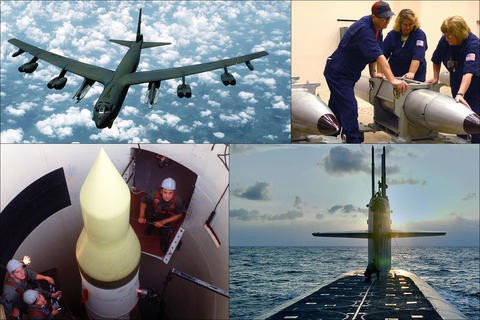What will it cost to deter a nuclear attack against the United States? The Congressional Budget Office (CBO) is required by law to project the 10-year costs of nuclear forces every two years. This report contains CBO’s projections for the period from 2019 to 2028. The CBO summary of the report is provided below:
- If carried out, the plans for nuclear forces delineated in the Department of Defense’s (DoD’s) and the Department of Energy’s (DOE’s) fiscal year 2019 budget requests would cost a total of $494 billion over the 2019–2028 period, for an average of just under $50 billion a year, CBO estimates.
- The current 10-year total is 23 percent higher than CBO’s 2017 estimate of the 10-year costs of nuclear forces, $400 billion over the 2017–2026 period.
- About $51 billion (or 55 percent) of the $94 billion increase in that total arises because the 10-year period covered by the current estimate begins and ends two years later than the period covered by the 2017 estimate. Thus, the period now includes two later (and more expensive) years of development in nuclear modernization programs. Also, costs in those two later years reflect 10 years of economywide inflation relative to the two years that drop out of the previous 10-year projection; that factor (in the absence of any changes to programs) accounts for about one-fourth of the $51 billion increase.
- About $37 billion (or 39 percent) of the $94 billion increase is projected to occur from 2019 to 2026—the eight years included in both this estimate and the 2017 estimate. That increase stems mainly from new modernization programs and weapons and more concrete plans for nuclear command-and-control systems.
Background
Nuclear weapons have been an important component of U.S. national security since they were developed during World War II. During the Cold War, nuclear forces were central to U.S. defense policy, and a large arsenal was built. Since that time, nuclear forces have figured less prominently in defense policy than conventional forces have, and the United States has not built any new nuclear weapons or delivery systems for many years.
The nation’s current nuclear forces are reaching the end of their service life. Those forces consist of submarines that launch ballistic missiles (SSBNs), land-based intercontinental ballistic missiles (ICBMs), long-range bomber aircraft, shorter-range tactical aircraft carrying bombs, and the nuclear warheads that those delivery systems carry. Over the next two decades, essentially all of those components of nuclear forces will have to be refurbished or replaced with new systems if the United States is to continue fielding those capabilities.
In February 2018, the Department of Defense released its Nuclear Posture Review (NPR), a report that laid out the current Administration’s plans for nuclear strategy and force structure. To a large degree, the report represents a continuation of the nuclear posture of the previous Administration, including continuing all major modernization programs. However, the report also proposes the development of several new nuclear capabilities, which have been the subject of some debate. Over the coming years, the Congress will need to make decisions about what nuclear forces the United States should field in the future and thus about the extent to which the nation will pursue the Administration’s nuclear modernization plans.
The $432 billion would fund the following items:
• Strategic nuclear delivery systems and weapons ($234 billion). This category consists of DoD’s funding for strategic nuclear delivery systems (the three types of systems that can deliver long-range nuclear weapons—SSBNs, ICBMs, and long-range bombers), DOE’s funding for activities related to the warheads used by those systems, and DOE’s funding for the nuclear reactors that power SSBNs.
• Tactical nuclear delivery systems and weapons ($15 billion). This category consists of DoD’s funding for tactical aircraft that can deliver nuclear weapons over shorter ranges; DOE’s funding for activities related to the warheads that those aircraft carry; funding for a new submarine-launched nuclear cruise missile (SLCM), as called for in the 2018 NPR; and funding for a warhead for that missile to carry.
• DOE’s nuclear weapons laboratories and their supporting activities ($106 billion). This category consists of funding for activities at nuclear weapons laboratories and production facilities that are not attributable directly to a specific type of warhead but that are related to maintaining current and future stockpiles of nuclear weapons.
• DoD’s command, control, communications, and early-warning systems ($77 billion). These systems allow operators to communicate with nuclear forces, issue commands that control their use, detect incoming attacks, and rule out false alarms. Projected annual budgets for all of those programs together rise steadily from $33.6 billion to $53.5 billion over the next decade, CBO estimates, increasing by roughly 60 percent between 2019 and 2028.
Photo of the Nuclear Triad: CBO
